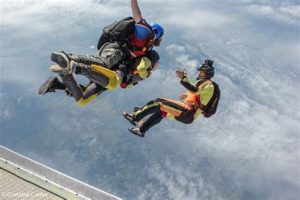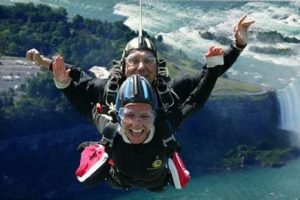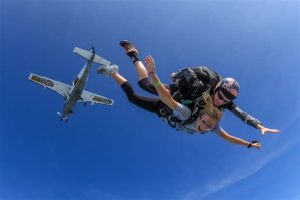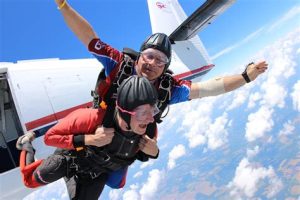Table of Contents
Curious about the speed of freefall during a tandem skydive? Discover how fast you’ll plummet through the sky as you soar towards the Earth in this thrilling adventure. Uncover the exhilarating sensation of terminal velocity and the incredible rush that comes with it. Get ready to experience the adrenaline-packed descent of a lifetime!
Have you ever wondered how fast you would fall when skydiving tandem? Well, get ready to be amazed as we dive into the exhilarating world of tandem skydiving! Strap in and prepare for a thrilling ride as we explore the speed at which you hurtle towards the earth during this adrenaline-pumping adventure. Whether you’re a first-time skydiver or a seasoned pro, understanding the rate of descent during tandem skydiving is sure to leave you in awe. So, let’s take a leap of faith together and uncover the secrets of how fast you truly fall when engaging in this heart-stopping activity.
Introduction
Welcome to the thrilling world of skydiving tandem! If you’ve ever wondered how fast you fall when participating in this exhilarating activity, you’ve come to the right place. In this article, we will explore the speed at which you descend during a tandem skydive and the factors that influence it.
The Freefall Experience
Skydiving tandem offers an incredible freefall experience where you can feel the rush of the wind against your face as you plummet through the sky. During this portion of the jump, you are not attached to the parachute yet, allowing you to experience the sensation of weightlessness and pure adrenaline.
Terminal Velocity
Terminal velocity is the maximum speed an object can reach while falling through the atmosphere. This speed is influenced by two main factors: gravity and air resistance. Initially, when you jump out of the plane, you will accelerate due to the force of gravity. However, as you gain speed, air resistance begins to counteract this acceleration until both forces balance out, resulting in a constant speed known as terminal velocity.
Calculating Terminal Velocity
The terminal velocity for a skydiving tandem is typically around 120 miles per hour (193 kilometers per hour). However, this value can vary depending on several factors:
Body Position
Your body position plays a significant role in determining your terminal velocity. If you maintain a streamlined and stable position, with arms and legs close to your body, you’ll reduce air resistance and increase your speed. On the other hand, if you spread out your limbs or adopt an unstable posture, it will create more drag, slowing you down.
Weight and Size
Heavier individuals tend to fall faster due to their increased mass. The more weight there is, the greater the force of gravity acting upon them. Similarly, size can also have an impact, as a larger surface area creates more air resistance, which can slow down the descent.
Altitude
The altitude at which you begin your skydive also affects your terminal velocity. As you descend, the atmosphere becomes denser, increasing air resistance and reducing your speed slightly. However, this change is minimal, and the overall impact on your freefall experience is negligible.
Duration of Freefall
The duration of your skydiving tandem’s freefall depends on the altitude from which you jump. On average, a freefall lasts approximately 60 seconds when starting from an altitude of 10,000 feet (3,048 meters). However, this time can vary depending on the altitude and other factors.
Conclusion
Skydiving tandem offers an adrenaline-pumping experience where you can reach speeds of around 120 miles per hour during freefall. Factors such as body position, weight, size, and altitude influence your terminal velocity. So, whether you’re a thrill-seeker or someone looking to conquer their fears, skydiving tandem promises an unforgettable adventure at breathtaking speeds!
Introduction
Welcome to our guide on how fast you fall during a tandem skydiving experience! In this guide, we will explore the speed at which you will descend when skydiving tandem and provide you with some useful insights. So, let’s get started and unravel the thrilling world of tandem skydiving speeds!
Understanding Tandem Skydiving
Tandem skydiving is a popular form of skydiving where you are harnessed to an experienced instructor. This allows beginners to experience the thrill of skydiving without extensive training. During a tandem skydive, the instructor takes care of all the technical aspects, ensuring a safe and enjoyable jump.
Acceleration During Freefall
During the initial moments of freefall, your speed will accelerate rapidly. Skydivers in tandem can reach speeds of approximately 120 miles per hour (193 kilometers per hour). Keep in mind that weather conditions and body positioning can influence this speed.
Terminal Velocity
Terminal velocity is the maximum speed at which an object falls due to gravity. For skydivers, terminal velocity is typically reached around 10-14 seconds after leaving the plane. At this point, you will experience a feeling of weightlessness, and your descent speed will stabilize.
Factors Affecting Fall Speed
Several factors influence the speed at which you fall during a tandem skydive. Your body mass, the surface area of your body facing the ground, and the altitude of the jump are significant factors. Additionally, minor alterations to posture or body shape can slightly affect your descent speed.
Parachute Deployment
As your tandem skydive nears its end, the instructor will deploy the parachute, significantly decreasing your fall speed. Parachutes slow down the descent speed to around 5-20 miles per hour (8-32 kilometers per hour). The parachute ride after deployment offers a gentler and scenic descent, allowing you to enjoy the breathtaking views.
Landing Approach
As you descend under the parachute, your instructor will guide the landing process. You will slowly descend, and the instructor will maneuver the canopy to ensure a safe and smooth landing. The landing speed can vary depending on wind conditions and the skill level of the instructor.
Conclusion
Tandem skydiving offers an adrenaline-pumping experience with incredible speeds during freefall. With speeds up to 120 miles per hour, the thrill of this adventure is truly unmatched. So, gather your courage, follow the instructions of your instructor, and prepare for an unforgettable tandem skydiving experience!Note: When providing instructions on skydiving, it is crucial to emphasize the importance of seeking professional training and adhering to safety guidelines.
When it comes to skydiving tandem, one of the most common questions that arises is how fast you actually fall. Well, let me break it down for you and provide a clear perspective on this exhilarating experience:
-
The initial moments:
-
As you exit the plane, you will experience an intense rush of adrenaline. The feeling of freefalling is unlike anything else you’ve ever experienced. Your body will be plummeting towards the ground at an astonishing speed.
-
The speed:
-
During the first few seconds, your speed can reach up to 120 miles per hour (193 kilometers per hour). This rapid descent creates an incredible sensation of weightlessness and an intense gust of wind against your face.
-
-
The duration:
-
Typically, the freefall lasts for about 30 to 60 seconds. However, keep in mind that this can vary depending on factors such as altitude, body size, and your skydiving instructor’s expertise.
-
-
-
The parachute deployment:
-
Once the parachute is deployed, you will experience a sudden deceleration. The transition from freefall speed to a slower descent allows you to catch your breath and take in the breathtaking views around you.
-
The controlled descent:
-
With the parachute open, your descent speed decreases significantly to around 15 miles per hour (24 kilometers per hour). This leisurely pace allows you to enjoy the scenery, appreciate the beauty of the surroundings, and even have a conversation with your instructor.
-
-
The landing:
-
As you approach the landing zone, your instructor will guide you towards a smooth touchdown. They are highly trained professionals who ensure that the entire experience is safe and enjoyable.
-
-
So, when it comes to skydiving tandem, prepare yourself for an adrenaline-pumping freefall at speeds of up to 120 miles per hour, followed by a serene descent under the parachute. It’s an experience that will leave you with memories to last a lifetime!
Thank you for taking the time to visit our blog and learn about the exhilarating experience of tandem skydiving! Before we conclude, we would like to provide you with some final instructions and information on how fast you fall during a tandem skydive. So let’s dive right in!
Firstly, it’s important to note that the speed at which you fall during a tandem skydive can vary depending on several factors. The most significant factor is your body position during freefall. Typically, skydivers aim to achieve a belly-to-earth position, which helps to maximize stability and control. When in this position, the average speed at which you fall is around 120 miles per hour (193 kilometers per hour). This incredible speed creates an adrenaline-pumping sensation that you won’t forget!
Transitioning from the aircraft to the freefall position is an exhilarating moment. As you exit the plane, you will experience a sudden rush of wind and a feeling of weightlessness as you start to accelerate downwards. Within a matter of seconds, you will reach terminal velocity, which is when the force of gravity pulling you down is equal to the resistance of the air pushing against you. At this point, you will be falling at approximately 120 miles per hour (193 kilometers per hour) until it’s time to deploy the parachute.
Finally, as you near the end of your skydive, the parachute will be deployed, and the experience shifts from a thrilling freefall to a gentle descent back to the ground. The parachute significantly slows down your descent speed, allowing you to enjoy the breathtaking views and soak in the incredible experience. During this canopy flight, you’ll have the opportunity to take in the surrounding scenery, feel the wind in your face, and perhaps even steer the parachute under the guidance of your instructor.
We hope that this article has given you a better understanding of how fast you fall during a tandem skydive. It truly is an adrenaline-fueled adventure that will leave you with memories to last a lifetime. If you have any further questions or would like to book your own tandem skydiving experience, please don’t hesitate to reach out to us. We look forward to sharing the thrill of skydiving with you soon!
Video How Fast Do You Fall When Skydiving Tandem
People also ask about how fast do you fall when skydiving tandem:
-
How fast do you fall when skydiving tandem?
When skydiving tandem, you can expect to reach speeds of around 120 miles per hour (193 kilometers per hour) during the freefall portion of the jump. This exhilarating speed gives you a sense of adrenaline and excitement as you experience the thrill of falling through the air.
-
Is skydiving tandem faster than solo?
No, skydiving tandem is not faster than solo skydiving. The speed at which you fall is primarily determined by your body position and the altitude at which you jump. Whether you are skydiving tandem or solo, the terminal velocity remains the same, which is around 120 miles per hour (193 kilometers per hour).
-
Is there any way to control the speed during a tandem skydive?
During a tandem skydive, you, as the passenger, do not have direct control over the speed. The experienced instructor who is attached to you will be responsible for managing the speed and ensuring a safe and enjoyable experience. They have the necessary training to adjust their body position and manipulate the parachute to control the descent rate.
-
How long does the freefall portion of a tandem skydive last?
The duration of the freefall portion during a tandem skydive typically lasts around 60 seconds. This thrilling minute allows you to enjoy the adrenaline rush, incredible views, and the sensation of weightlessness before the parachute is deployed for a smooth and scenic descent under the canopy.
-
What happens if the parachute doesn’t open during a tandem skydive?
Tandem skydiving equipment is designed with safety measures in place, including a reserve parachute. In the rare event that the main parachute fails to open, the instructor will initiate the deployment of the reserve parachute. They are extensively trained to handle emergency situations, ensuring a safe landing even if the main parachute malfunctions.






